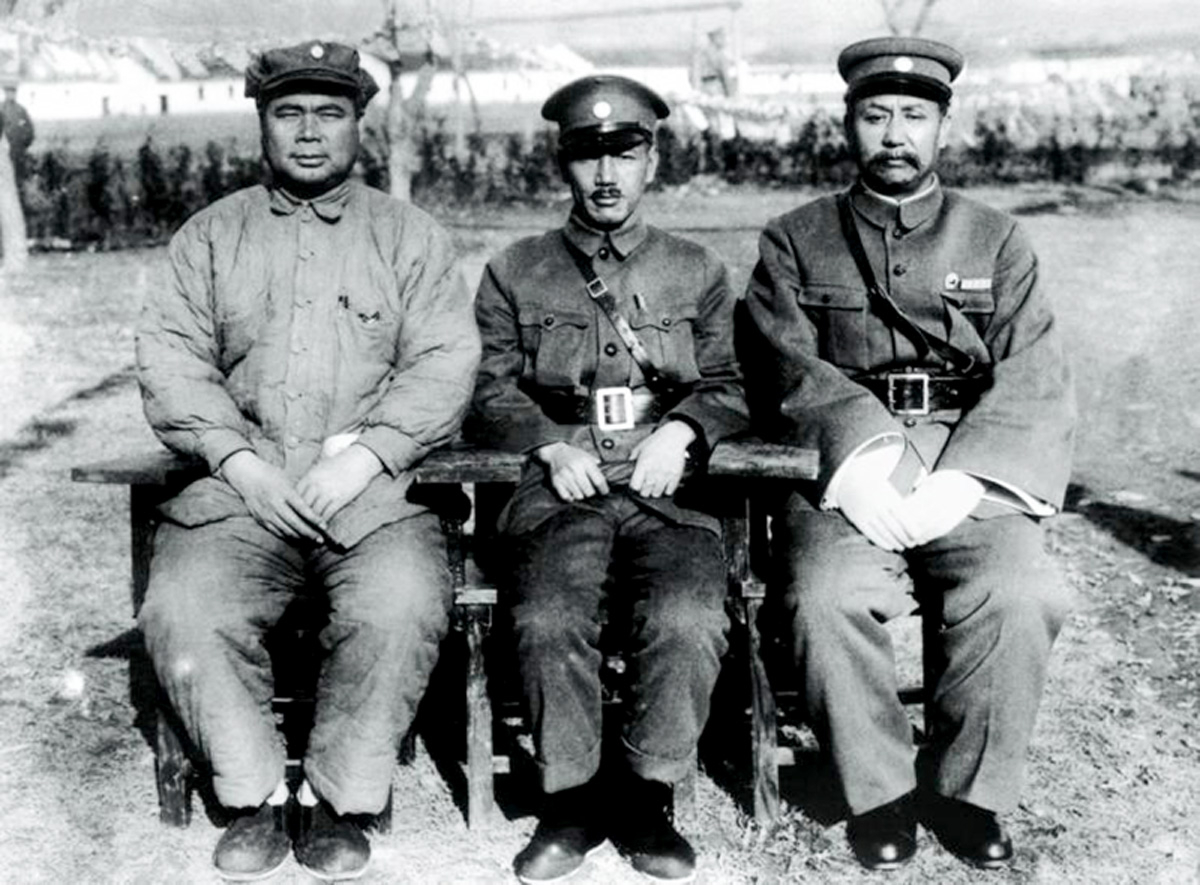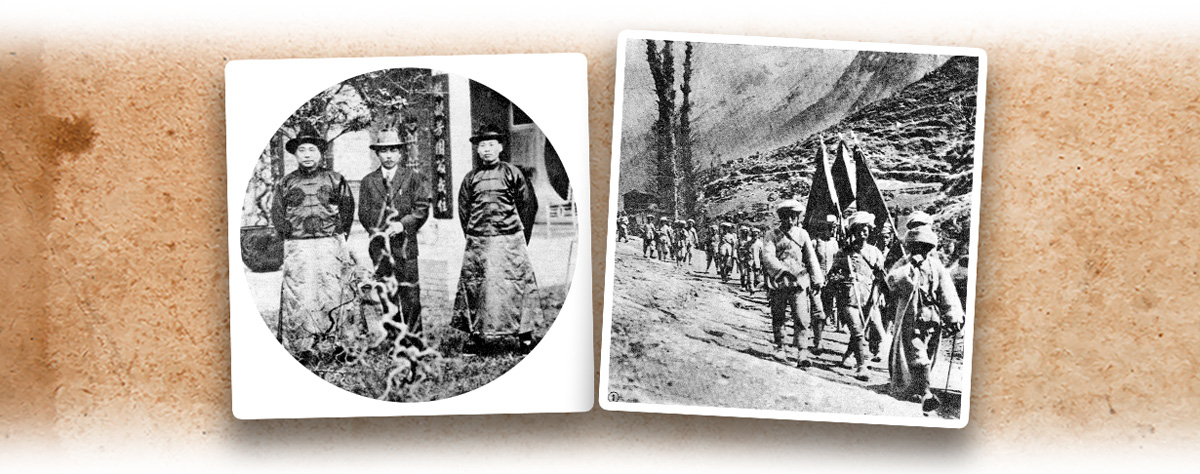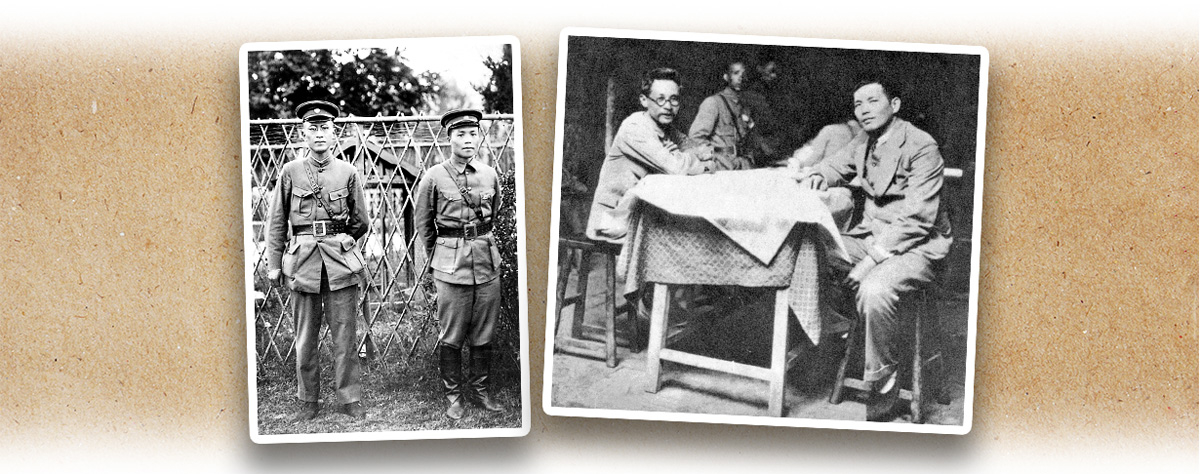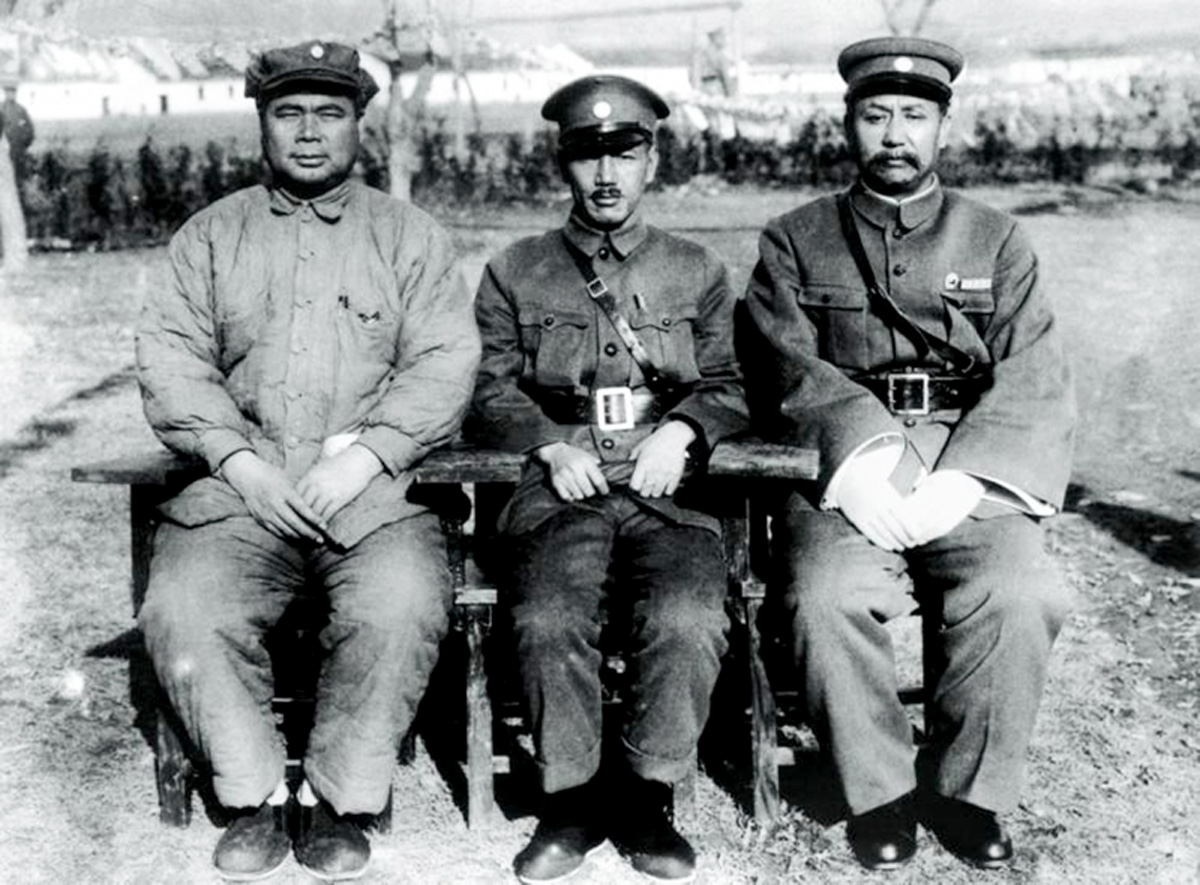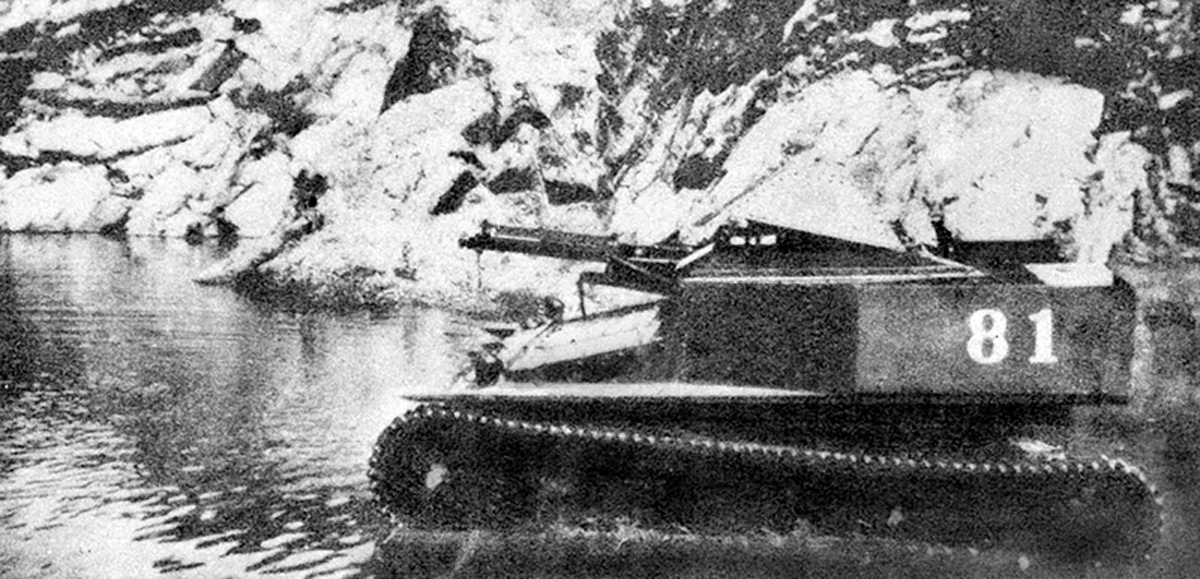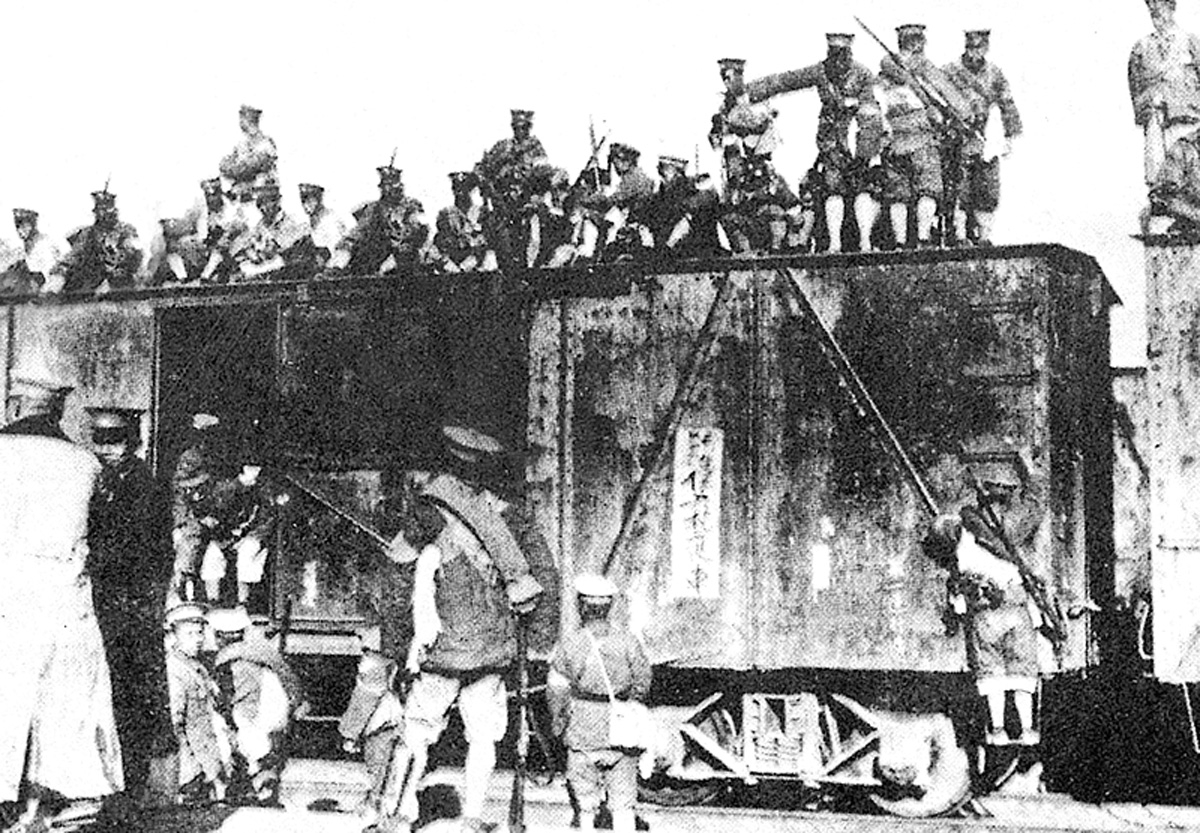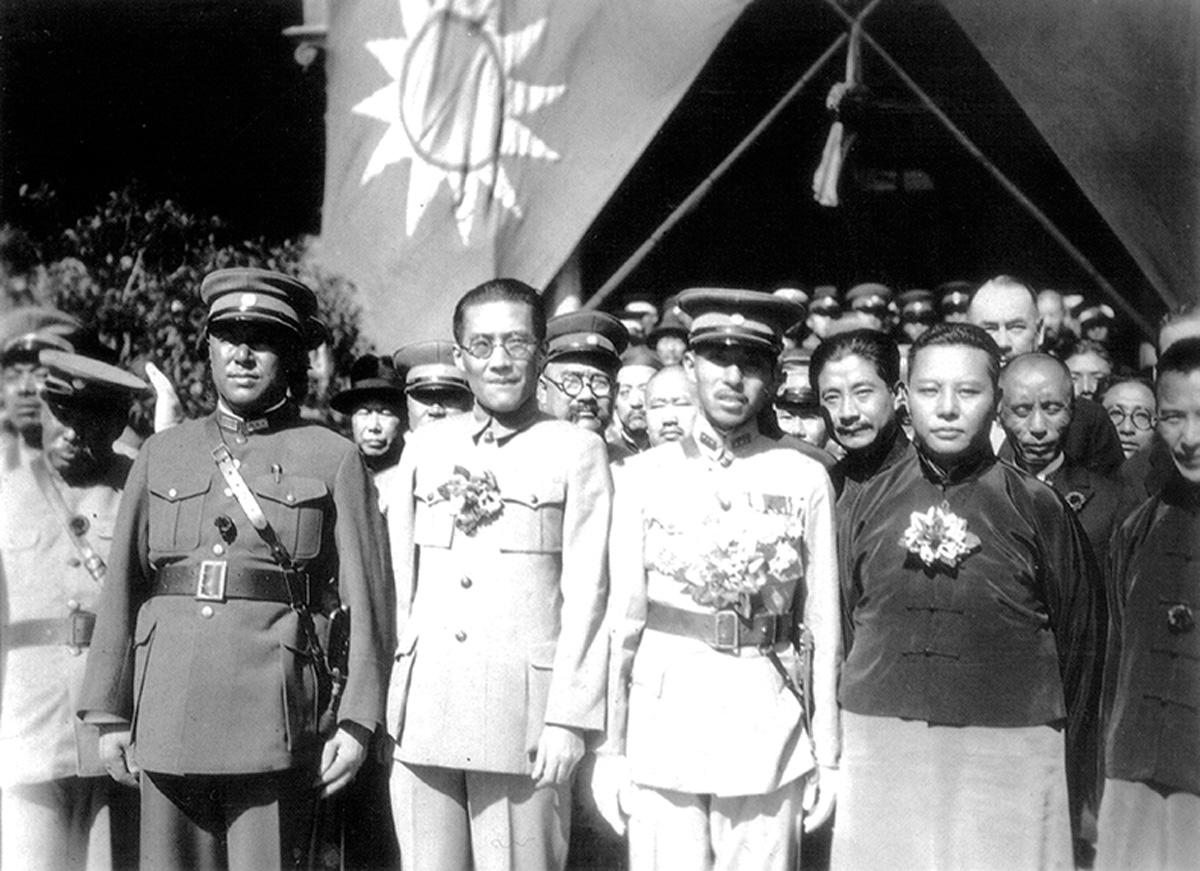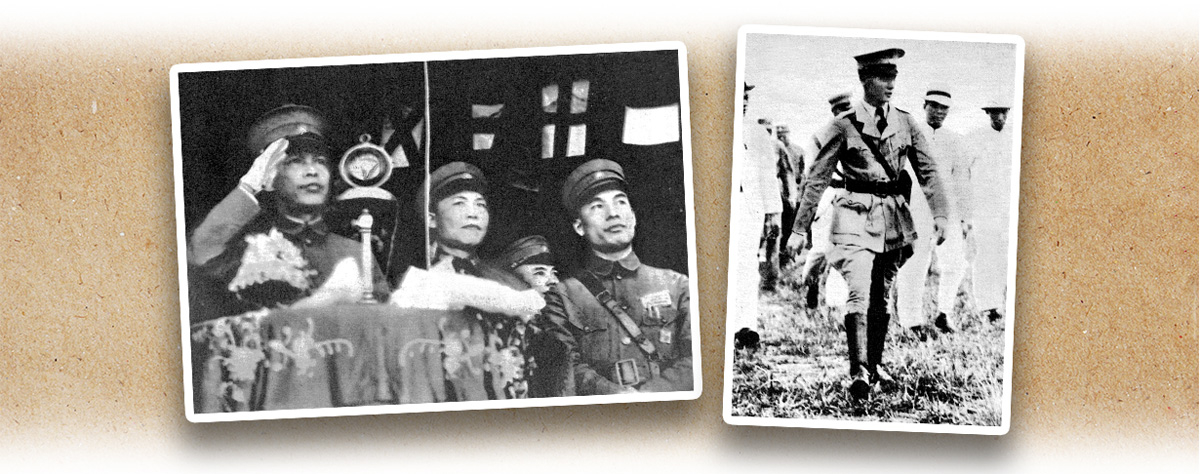The Northern Expedition originally took place to eliminate the old warlords. After the war, however, the victor camp split into many self-reliant and armed warlord factions. Among them were Chiang Kai-shek (蔣介石), Guangxi clique (桂﹝廣西﹞系), Feng Yuxiang (馮玉祥), and Yan Xishan (閻錫山) that evolved from the four major army groups of the Northern Expedition.
Chiang’s clique reunified the whole country in name. His “Direct Descent” represented the central government; Guangxi clique: it was formed based on the original Guangxi warlords including Li Zongren (李宗仁) and Bai Chongxi (白崇禧); Feng’s clique: formed by Feng’s original Northwest Army. Yan’s clique: formed by Yan with the force of Shanxi clique (晉﹝山西﹞系). In addition, there were various regional new and old factions reshuffled, such as: the Fengtian clique (奉﹝奉天﹞系) of Zhang Xueliang (張學良) in the Northeast; the Yunnan clique (滇﹝雲南﹞系) of warlords including Long Yun (龍雲) and Lu Han (盧漢); the Sichuan Army (川軍) formed by Liu Xiang (劉湘), Liu Wenhui (劉文輝), and others who worked independently from one another; the Guizhou clique (黔﹝貴州﹞系) formed by Zhou Xicheng (周西成), Wang Jialie (王家烈), etc.; the Guangdong clique (粵﹝廣東﹞系) formed by Chen Jitang (陳濟棠) and his associates; the Hunan clique (湘﹝湖南﹞系) of Tang Shengzhi (唐生智), Cheng Qian (程潛), He Jian (何鍵), etc.; the Ma clique ran by the warlords shared the surname “Ma” including Ma Hongbin (馬鴻賓), Ma Hongkui (馬鴻逵), Ma Bufang (馬步芳), and Ma Zhongying (馬仲英) who occupied the provinces of Gangsu (甘肅), Ningxia (寧夏), and Qinghai (青海) respectively; Sheng Shicai (盛世才), the de facto ruler of Xinjiang (新疆), and so on.
As early as June 1928 when the Northern Expedition Army captured Beijing (北京), Chiang invited the heads of different army groups including Feng, Yan, and Li to discuss the issue of military reorganisation and demilitarisation. However, these meetings were inconclusive and even evolved into fierce struggles among the cliques. At that time, there were constant civil wars among the new regional warlords, two of which were the fiercest: the Direct Descent-Guangxi Clique War and the Central Plains War.
The Direct Descent-Guangxi Clique War broke out between the Chiang’s faction and the Guangxi clique led by Li and others from March to June 1929. The Guangxi clique was defeated and lost the provinces of Hunan (湖南) and Hubei (湖北).
The anti-Chiang war by Feng, Yan, and Li, which was also known as the Central Plains War as it broke out in what was known as “Central Plains” in ancient China that covers areas including Henan Province (河南) from May to November 1930. Yan telegrammed the anti-Chiang proposal and formed the anti-Chiang coalition with warlords including Feng and Li with a total force of more than 600,000. The coalition even established their own nationalist government. Chiang deployed more than 700,000 troops to fight in the war. The seven-month long fierce war caused more than 300,000 casualties and ended with Chiang’s victory when Zhang led his Fengtian clique army through the Shanhai Pass (山海關) to support.
|
|
What is the Central Plains War? Please briefly introduce the deployment and situation of the warring parties. |
|
|
See answer below. |
Left: Generals of the Sichuan Army, from the left: Deng Xihou (鄧錫侯), Yang Sen (楊森), and Liu Wenhui (劉文輝). Right: Liu’s troop of the Sichuan Army marching in 1934. During the Nanjing (南京) Nationalist Government era, the whole country was basically reunified. However, many parts of China were still controlled by warlords. Those self-reliant and armed warlords were called “new warlords”, many of them only supported the Nanjing government in name only. For example, the new warlords in Sichuan acted on their own free wills and fought each other from time to time, while the Central Government could not interfere. Those cliques with huge military forces such as Feng, Yan, and Guangxi were even strong enough to compete with the Nanjing Central Government.
On 25 January 1929, attendees of the National Army Demilitarisation Conference took a group photo when it closed in Nanjing. Front row: Third from the left was Li Zongren, fifth from the left was Feng Yuxiang, eighth from the left was Chiang Kai-shek, ninth from the left was Yan Xishan. Back row: First from the right was Bai Chongxi. With the Nationalist Government’s intention to disarm after the Northern Expedition, those cliques with huge military forces such as the Feng’s, Yan’s, and the Guangxi’s were the most affected. The conflict between the Chiang-led Nanjing Central Government and those heavily armed cliques worsened.
From March to June 1929, the Direct Descent-Guangxi Clique War broke out. The three main leaders of the Guangxi clique were Li Zongren, Bai Chongxi, and Huang Shaohong (黃紹竑). Left: A photo of Li (right) and Bai (left) on 5 May 1929 during the Direct Descent-Guangxi Clique War. Right: Huang Shaohong (right) stayed behind to protect Guangxi during the war.
During the Direct Descent-Guangxi Clique War, Chen Jitang (陳濟棠) supported Chiang Kai-shek and advanced on Guangxi. In June 1929, the war ended with Chiang’s victory.
From left: Feng Yuxiang, Chiang Kai-shek, and Yan Xishan. The three took a group photo at the National Army Demilitarisation Conference in January 1929. From May to November of the following year, Feng and Yan joined the Guangxi clique to fight against Chiang. The Central Plains War broke out.
Chiang Kai-shek’s tank fought in the Central Plains War. Chiang was stronger in terms of financial resources and weaponry compared to that of the cliques of Feng, Yan, and Guangxi.
By September 1930, Chiang Kai-shek had the upper hand in the Central Plains War. The photo shows his army attacking along the railway.
At first, Zhang Xueliang, the head of the Fengtian clique and commander-in-chief of the Northeast Army, remained neutral in the Central Plains War. To win the war as soon as possible, Chiang Kai-shek sought Zhang’s support by granting him high-level post and military subsidisation. In September 1930, Zhang led his army to advance southward through the Shanhai Pass. Confrontation from both Chiang and Zhang doomed Feng Yuxiang and Yan Xishan to defeat. In November, the war ended with Chiang’s complete victory. The photo shows the inauguration ceremony of Zhang (third from left in the front row in military uniform and military cap) as deputy commander-in-chief of the Nationalist Government’s Army, Navy, and Air Forces in Shenyang (瀋陽) in October 1930.
Famine combined with war devastated millions of lives. Left: From 1928 to 1930, famine occurred in the provinces of Shaanxi (陝西), Gansu (甘肅), and Henan (河南). A large number of victims were waiting for relief. Right: During the Central Plains War in 1930, many civilian houses in Xuchang (許昌), Henan, were bombed.
From 1928 to 1930, famine occurred in Shaanxi and Gansu in northwest China, and Henan in the Central Plains. At first, the Nanjing Nationalist Government paid attention and provided relief to the victims. In 1930, the Central Plains War broke out. As the northwest territory was the Feng Yuxiang’s turf, the Nanjing Central Government thus changed its attitude towards disaster relief as it did not want to benefit him. Meanwhile, the political situation concerned the people and therefore they dared not organise relief activities. During the war, Henan was the main battlefield. The war together with the political situation exacerbated the famine, which killed millions of people.
The disputes between the new warlords and Chiang Kai-shek continued following the Central Plains War. In June 1936, the Guangdong warlord Chen Jitang and the Guangxi clique joined forces against Chiang, which was known as the “Guangdong-Guangxi Incident” (兩廣事變). In July of the same year, Huang Guangrui (黃光銳), the commander of the Guangdong Air Force, led his 48 planes to turn to the Nanjing government. Chen’s subordinates including General Yu Hanmou (余漢謀), also expressed their obedience to the Central Government. Chen was forced to flee to Hong Kong, which gave Nanjing Government the opportunity to control Guangdong. Left: Chen (left) and Li Zongren (middle) reviewing troops in Guangzhou (廣州) in 1935; Right: Huang, Chen’s subordinate. He was also the commander of the Guangdong Air Force.
It was said that Chen Jitang believed in feng shui and numerology. Before opposing Chiang Kai-shek, he turned to a fortune teller and got the message that “ji bukeshi” (機不可失), literally means “the opportunity must not be missed”. Thinking that the right time had come, he decided to act. However, it turned out that the “ji” should have been interpreted as plane (“feiji”, 飛機) instead of opportunity (shiji, 時機). Since Chen’s Guangdong Army was no match for Chiang’s, the Guangdong Air Force thus became his trump card in the revolt. Therefore, when Huang Guangrui took the air force to join Chiang, Chen lost his ace and the anti-Chiang plan failed.
|
|
What is the Central Plains War? Please briefly introduce the deployment and situation of the warring parties. |
|
|
The Central Plains War (also known as the Chiang Kai-shek’s War against Feng Yuxiang, Yan Xishan, and Li Zongren) broke out from May to November 1930. The war was named because the main battlefield was in Henan and other areas located in what was known as the “Central Plains” in ancient times. During the Northern Expedition, Chiang, Feng, Yan, Li, and others served as commander-in-chief of the First, Second, Third, and Fourth Army Group respectively. However, after the victory of the Northern Expedition, Chiang’s army became the “Direct Decedent”. He even pressed to demilitarise other cliques that provoked disputes. From March to June 1929, the war between Chiang and the Guangxi clique broke out. On 10 February 1930, Yan telegrammed Chiang and urged him to made comity for the good of the nation and to settle the inter-clique conflicts. Later, 45 people including Yan, Feng, and Li telegrammed jointly to call for a KMT voting to resolve disputes. The 57 generals of the former Second, Third, and Fourth Army Group urged Chiang to step down in a joint telegram. To advocate the use of military force to revolt Chiang, they recommended Yan as commander-in-chief of the Republic of China’s Army, Navy and Air Forces, and Feng and Li as deputy commanders. On 5 April, the Nationalist Government listed Yan as wanted and actively prepared for the war. The anti-Chiang camp mobilised a force of more than 600,000, while Chiang, serving as commander-in-chief, deployed a force of more than 700,000 for combat. The battle kicked off in May. To fight against Chiang, Yan and Feng attempted to seize Xuzhou (徐州), an important strategic point. Yan’s army marched to the south from Tianjin-Pukou Railway (津浦鐵路), and Feng’s army advanced eastward from Gansu-Haizhou Railway (隴海鐵路). Meanwhile, Li’s army advanced on Hunan threating Wuhan (武漢). At the beginning of the war, the anti-Chiang army obtained control in both north and south battlefields. However, Chiang’s army started to gain the upper hand in late July. On 1 September, Yan, Feng, and other commanders formed another Nationalist Government in Beiping (北平), creating a standoff with the Nanjing Nationalist Government who fought against it to be the legit regime to rule China. The Northeast warlord Zhang Xueliang, who was initially on a wait-and-see approach, once telegrammed to express his neutrality but later showed gradual support for Chiang. It was not until after he assumed the post of deputy commander-in-chief of the Nationalist Government's Army, Navy, and Air Forces on 9 October 1930 that he swiftly led his troops to advance southward through the Shanhai Pass. Since then, the anti-Chiang army gradually lost. On 4 November, Yan and Feng telegrammed to dismiss the headquarters of the navy, army and air forces. This marked the end of the seven-month-long Central Plains War, which involved more than a million forces. This civil war that claimed over 300,000 lives and 500 million military expenditure was the largest of its kind since the founding of the Republic of China. |
Source of most photos used in this feature piece: Fotoe (pictures 1, 3, 4, 6, 7, 9, 10), Visual China Group (picture 8), and misc. photo sources.




